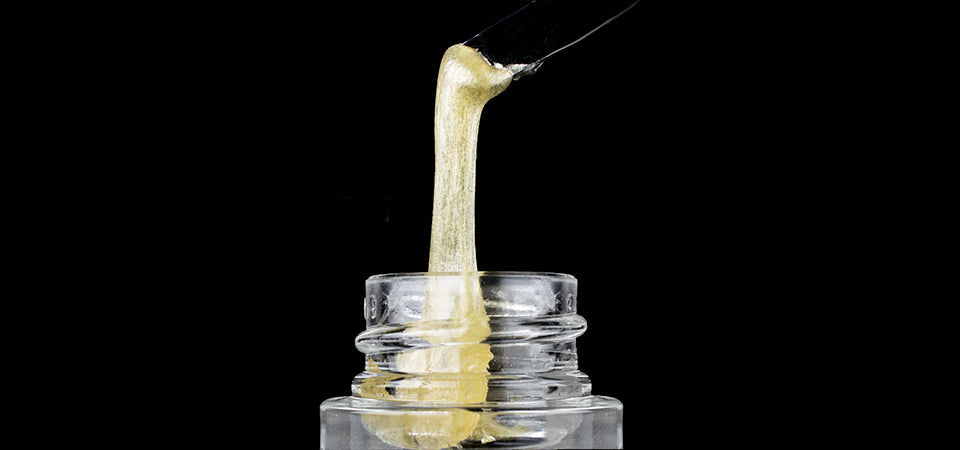What Solventless Means for Cannabis Extracts

"Solventless" refers to cannabis extracts that are made using mechanical separation techniques rather than chemical solvents like butane, propane, ethanol, or supercritical CO2. Whereas "solventless" or "non-solvent" cannabis concentrates are made without any involvement from solvents whatsoever, "solvent-free" refers to extracts like distillate that were initially made using solvents, but from which all residual solvent has been removed.
If you're interested in making solventless concentrates commercially or for personal use, it can be helpful to familiarize yourself with the wide range of cannabis concentrates you can make using mechanical separation techniques—from lower-grade extracts like kief to highly potent extracts like rosin. It can also be helpful to understand the unique benefits of solventless concentrates for the manufacturer, the consumer, and your ROI.
Cannabis Concentrates That Can Be Made Using Solventless Extraction Methods
There are several kinds of solventless extracts you can make, some of which are more highly refined than others. Here, we've ordered the main solventless cannabis extracts by purity, starting with the most basic concentrates and working up to the purest (and most potent) cannabis extracts at the end.
Kief
Kief is the green-brown substance that falls through to the bottom of a cannabis grinder when you grind dried cannabis flower. It contains resin-containing trichome heads, along with plant material, including ground-up sugar leaves and pistils.
Because it's higher in cannabinoids and terpenes than whole flower (containing around 50% THC on average), kief is often added to joints or sprinkled over a bowl (referred to as "crowning a bowl") to add an extra kick. For commercial purposes, the best use for kief is to press it in a rosin press and use the resulting food-grade rosin to make edibles (as kief rosin isn’t pure enough to sell for dabbing).
Hashish

Hashish is probably the oldest concentrate that was made from the cannabis plant in countries like Morocco, Pakistan, Afghanistan, and Lebanon. Traditionally, dried cannabis flowers would be beaten or rubbed across silk screens to collect the trichome heads. The trichomes would then be sifted and squished together using pressure to make bricks that contained between 5 and 40% THC, according to samples collected between 1995 and 2014. Over time, the consumer would remove small pieces from the brick and smoke the hash, sprinkle it over a bowl, etc.
Hand-Rubbed Hash or Charas
A similar preparation—known as charas—was traditionally made in Bhutan, Nepal, and Northern India by rubbing cannabis buds between the hands. This method isn’t typically used by commercial producers in North America because it isn’t considered sanitary.
“Import Hash”
In the 1960s, hashish was frequently imported from overseas because cannabis concentrates weren't widely available. However, much illegal import hash, especially in Europe, has been found to be contaminated with mold and E. Coli, so unless you’re traveling to Central Asia and plan to consume fresh hashish while you’re there, it’s usually better to make your own.
If you’re thinking about the kinds of solventless concentrates that you could sell commercially, you can either make and sell “old-world hash” in its traditional form or focus on more modern concentrates like dry sift or ice water hash, both of which you can press and sell as rosin for dabbing.
Dry Sift
Dry sift is the refined version of kief. It can be obtained in three ways:
- By rotating cannabis flower inside a mesh cylinder at cold temperatures
- By sifting (pre-separated) kief through a graduated series of mesh screens to filter out the plant material
- By using an implement such as a paint roller to lift out the organic debris using static electricity (referred to as “static sift tech”)
If using the second extraction method, you can obtain the initial kief in a wide variety of ways, ranging from manually agitating dried cannabis flower over a mesh screen to shaking cannabis material in a bag with dry ice (we don't recommend this) or liquid nitrogen.
For dry sift that's pure enough to dab ("full melt dry sift"), you're looking at post-processing techniques that use static electricity to remove all of the plant matter, leaving only the trichomes for a potency of around 50% to 60% THC. This is a very time-consuming process, but is the gold standard of making top-shelf sift and you can achieve stellar results once you become skilled at it. If you prefer, you can also press your dry sift to extract top-quality rosin that can then be used for dabbing or vaping.
Ice Water Hash AKA Bubble Hash AKA Ice Water Extraction (IWE)
Ice water extraction results in the purest solventless concentrate out of those you can make by hand. Ice water hash, also known as ice water extraction (IWE) and bubble hash (because it bubbles when dabbed), is made by submerging fresh frozen, frozen, or dried-and-cured cannabis buds or cannabis trim in ice water. After agitating the cannabis material in the ice water, the trichomes sink to the bottom and are collected in a mesh bag (aka bubble bag) while the plant material floats to the top.
For larger operations, there is now hash washing equipment that completes the entire process for you with minimal manpower required and a quick and easy cleanup at the end. After collecting the bubble hash, you can freeze dry it and either dab it, sell it as-is, or press it to make hash rosin.
Rosin

Rosin is the most popular solventless concentrate for commercial production because it's dab-ready and contains THC levels of around 60% to 70%, and sometimes as high as the low 80s. Rosin is produced by applying heat and pressure to bubble hash, dry sift, kief, or cannabis flower, causing the trichomes to open and the sticky resin to run out. To make live rosin (the solventless equivalent of live resin), first make bubble hash with fresh frozen cannabis, freeze dry the hash, then press it at low rosin pressing temperatures for maximum terpene preservation and potency.
By applying different temperatures, pressing times, and post-processing techniques, rosin can be transformed into a range of consistencies after extraction, including budder, sap, shatter, jam, sauce, and diamonds. You can also process rosin to make vape cartridges or infuse it (or the rosin chips that are left behind) into butter or oil to make edibles.
THCA and Terpene Sauce

THCA is the most highly refined extract you can make using mechanical separation techniques. To separate THCA from terp sauce using a rosin press, you can press waxy rosin in a 25µm bag at low temperatures of 130 to 140 °F with very low pressure, then repeat at 160 to 170 °F, again at 200 to 210 °F, and do a final light press at 230 to 240 °F. Throughout this process, the terpene sauce runs out onto the parchment paper and the THCA diamonds are left behind in the bag, having a white, crystalline appearance. The terp sauce can then be used to make solventless rosin carts.
Alternatively, you can make solventless rosin cartridges with jar tech. Heating high-quality rosin (usually hash rosin) in a sealed jar in the oven at 150 °F for 24 to 48 hours decarbs the rosin and lowers its viscosity. You can then smash out the bubbles with a syringe, deposit the liquid rosin into your carts, and wick your cartridges in the oven at 100 °F for 5 minutes.
Is Solventless Better than Solvent-Based?
Now that solventless concentrates have become more mainstream, the question of whether they're superior to solvent-based extracts is of interest both to producers and consumers. Personally, we think that solventless concentrates are superior to solvent-based concentrates. However, it really depends on what you’re looking for.
Solventless Concentrates Come With an Assurance of High-Quality Starting Material
The starting material for solventless extraction is necessarily of a high quality because contaminants aren't automatically removed in the pressing process (whereas they often are with solvent-based extraction techniques). In order to pass quality testing, solventless concentrates can only be made from plant material that’s free from mold, yeast, bacteria, heavy metals, and non-permitted pesticides.
There Is No Chance of Inhaling Chemical Solvents With Solventless Extracts
The second most important advantage of solventless concentrates is that there's no chance of there being any residual solvent in the final product because no chemical solvent was used during the extraction process. This makes solventless concentrates appealing to medical and health-conscious consumers because they want to inhale or ingest something that's clean.
The Extraction Process Is Safer for Home Extractors
In terms of home extraction, solventless extraction techniques are far safer than DIY solvent-based extraction techniques. Sifting, washing, or pressing rosin at home all come without the risk of explosions or fire that come with home butane hash oil production (although professional closed-loop systems are quite safe).
From a legal perspective, many states allow home-growers to produce solventless extracts at home for personal use but don’t permit hydrocarbon extraction without a special license and a certified hydrocarbon extraction space. That makes solventless extraction much more accessible for people who want to dip their toe in the water without making a six-figure commitment.
Solventless Concentrates Fetch a Higher Price in Dispensaries
Cannabis connoisseurs will pay a much higher price for a solventless extract compared to a solvent-based extract for several reasons:
- Solventless extracts don’t contain any residual solvent or come with overtones of butane or propane.
- Solventless extracts don’t require the use of fossil fuels, making them attractive to environmentally conscious consumers.
- Live solventless extracts are extremely flavorful because the terpene profile is essentially the same as it was at the point of harvest.
- As mentioned previously, solventless extracts are made from very high-quality flower because the extraction process doesn’t kill or remove mold, bacteria, heavy metals, pesticides, or yeast.
For all of these reasons, solventless concentrates sell at a higher price point than solvent-based extracts, even though the extraction equipment itself costs only a fraction of the upfront investment for a closed-loop solvent-based extraction system (including those used for supercritical CO2 extraction). If you've ever dabbed or vaped very pure solventless extracts, you will also attest to the fact that the flavor and potency are second to none.
Solventless Is the Way of the Future
"Solventless concentrates," in terms of cannabis extracts, cover everything from kief and hash to rosin, THCA diamonds, and terpene sauce. The defining factor is the fact that these extracts were obtained using mechanical separation techniques rather than dissolving the active compounds with solvents.
While solvent-based extracts like butane hash oil can be purged or distilled to remove the residual solvent (and CO2 evaporates off the extract almost instantly), solventless extracts like rosin still shine brighter in terms of flavor and the assurance of a high-quality starting material. For extraction professionals, solventless also offers a more accessible extraction process with a higher ROI, making it the obvious choice for anyone who wants to produce premium extracts and reap the financial rewards.



